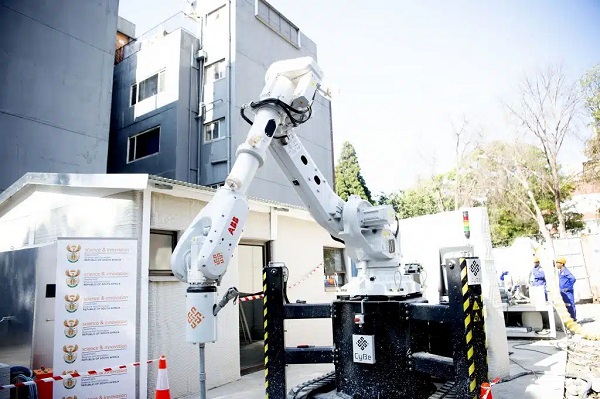At the start of this year, the University of Johannesburg (UJ) made history by finishing South Africa’s first-ever 3D printed building.
The project was a collaboration between UJ’s Department of Architecture and Design, and the Department of Science and Innovation (DSI).
The building, which is a one-room structure, was completed in under eight hours using 3D printing technology on UJ’s Doornfontein campus. The process employed a CyBe Robot Crawler, which used a cement-based material to create the walls of the building layer by layer.
The printer was operated by a team of experts, including outgoing UJ Vice-Chancellor and Principal Professor Tshilidzi Marwala, who ensured that the printing process was smooth and accurate.
The experts were really impressed with the printer’s construction time, as it can produce buildings much faster than traditional construction methods. “This is among the last projects that will be rolled out during my tenure as Vice-Chancellor of this University, and it is one I am particularly excited about!”, said Prof. Marwala at the launch event at UJ’s Doornfontein Campus.
Quick and cheap production
Apart from the production speed of 3D concrete printing, the relatively low costs of the technique also had an impact on the university’s staff. Professor Jeffrey Mahachi, head of the Civil Engineering & The Built Environment School at UJ, was dazzled by how cheap it was to print the project.
“The interesting thing is you can print a house in 8 hours, the quality is excellent, and the product is cost-effective,” Mahachi noted about the structure. In that statement he was more than right, as the entire house was built within the span of a day, much faster than traditional construction.
Furthermore, the production speed and costs could very well improve in the future. Dr. Khululekani Ntakana, lecturer at UJ, correctly mentioned that the technology is still in its infant stages, and that research is still being conducted every day.
It is uncertain what the future holds for 3D concrete printing, but with UJ joining the worldwide research on the construction technique, the future sure looks promising!
An improvement to South African construction
The completion of the 3D printed building is a significant milestone for the South African construction industry. It demonstrates that 3D printing technology can be used to build structures quickly and efficiently. As this innovative technology is so efficient, the UJ project is expected to pave the way for future developments in the construction industry.
The use of 3D printing technology in construction could lead to faster construction times, reduced costs, and improved quality. Due to all these advantages, the technology has the potential to address the housing shortage in South Africa by providing affordable and sustainable housing solutions.
As Dr Blade Nzimande said, the country currently faces a shortage of over 23 million houses. The backlog of affordable housing has been going on for over two decades, and local experts on the subject are excited that 3D printing technology could offer a possible solution to this problem.
Worldwide experience
As CyBe Construction is getting ready for its 10 year anniversary, its track record of worldwide projects has grown to look very promising. Since being founded in the legacy of Hendriks Construction, a 100-year-old industry leader, CyBe has had partners all around the world.
Time after time, the company has proven to be able to offer faster, cheaper, and more sustainable construction solutions. The company’s collaboration with Johannesburg, therefore, marks a significant milestone for South Africa’s construction industry.
The completion of the country’s first 3D printed building demonstrates the potential of 3D printing technology in providing quick, efficient, cost-effective, and high-quality building solutions. The use of this technology could help address the critical issue of housing shortage in the country, providing affordable and sustainable housing solutions.
As CyBe’s CEO and founder, Berry Hendriks, and the company share a vision for an improved society, the company is happy to be able to lend a hand in solving this crisis. With the completion of the first 3D printed building and the ongoing research in the field, the future looks promising for the construction industry in South Africa.
Also Read
Chinese electromotive group mulls battery plant in Morocco
Africa Investment Forum showcases $1.475b in renewable energy deals

